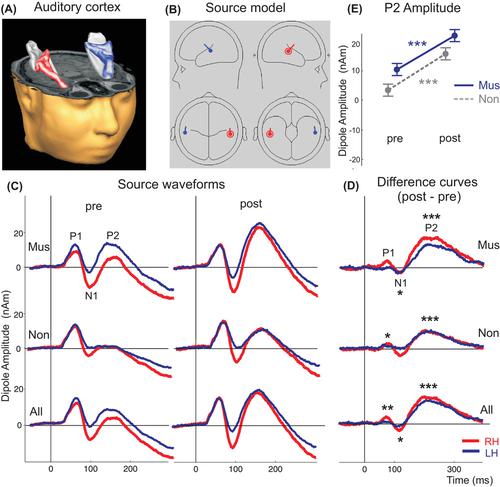当前位置:
X-MOL 学术
›
Ann. N. Y. Acad. Sci.
›
论文详情
Our official English website, www.x-mol.net, welcomes your feedback! (Note: you will need to create a separate account there.)
Short-term plasticity of neuro-auditory processing induced by musical active listening training
Annals of the New York Academy of Sciences ( IF 5.2 ) Pub Date : 2022-09-16 , DOI: 10.1111/nyas.14899 Peter Schneider 1, 2, 3, 4 , Christine Groß 1, 3 , Valdis Bernhofs 3 , Markus Christiner 3, 4 , Jan Benner 1, 2 , Sabrina Turker 5 , Bettina M Zeidler 4 , Annemarie Seither-Preisler 4, 6
Annals of the New York Academy of Sciences ( IF 5.2 ) Pub Date : 2022-09-16 , DOI: 10.1111/nyas.14899 Peter Schneider 1, 2, 3, 4 , Christine Groß 1, 3 , Valdis Bernhofs 3 , Markus Christiner 3, 4 , Jan Benner 1, 2 , Sabrina Turker 5 , Bettina M Zeidler 4 , Annemarie Seither-Preisler 4, 6
Affiliation

|
Although there is strong evidence for the positive effects of musical training on auditory perception, processing, and training-induced neuroplasticity, there is still little knowledge on the auditory and neurophysiological short-term plasticity through listening training. In a sample of 37 adolescents (20 musicians and 17 nonmusicians) that was compared to a control group matched for age, gender, and musical experience, we conducted a 2-week active listening training (AULOS: Active IndividUalized Listening OptimizationS). Using magnetoencephalography and psychoacoustic tests, the short-term plasticity of auditory evoked fields and auditory skills were examined in a pre-post design, adapted to the individual neuro-auditory profiles. We found bilateral, but more pronounced plastic changes in the right auditory cortex. Moreover, we observed synchronization of the auditory evoked P1, N1, and P2 responses and threefold larger amplitudes of the late P2 response, similar to the reported effects of musical long-term training. Auditory skills and thresholds benefited largely from the AULOS training. Remarkably, after training, the mean thresholds improved by 12 dB for bone conduction and by 3–4 dB for air conduction. Thus, our findings indicate a strong positive influence of active listening training on neural auditory processing and perception in adolescence, when the auditory system is still developing.
中文翻译:

音乐主动聆听训练诱导的神经听觉处理的短期可塑性
尽管有强有力的证据表明音乐训练对听觉感知、处理和训练诱发的神经可塑性有积极影响,但关于听力训练对听觉和神经生理学短期可塑性的了解仍然很少。在将 37 名青少年(20 名音乐家和 17 名非音乐家)与年龄、性别和音乐经验相匹配的对照组进行比较的样本中,我们进行了为期 2 周的主动听力训练(AULOS:主动个性化听力优化)。使用脑磁图和心理声学测试,在前后设计中检查听觉诱发场和听觉技能的短期可塑性,以适应个体神经听觉特征。我们在右侧听觉皮层发现了双侧但更明显的塑性变化。而且,我们观察到听觉诱发的 P1、N1 和 P2 反应的同步以及晚期 P2 反应的三倍幅度,类似于音乐长期训练的报告效果。听觉技能和阈值在很大程度上受益于 AULOS 培训。值得注意的是,训练后,骨传导的平均阈值提高了 12 dB,气导的平均阈值提高了 3–4 dB。因此,我们的研究结果表明,主动聆听训练对青春期的神经听觉处理和感知具有强烈的积极影响,此时听觉系统仍在发育。骨传导的平均阈值提高了 12 dB,气导的平均阈值提高了 3–4 dB。因此,我们的研究结果表明,主动聆听训练对青春期的神经听觉处理和感知具有强烈的积极影响,此时听觉系统仍在发育。骨传导的平均阈值提高了 12 dB,气导的平均阈值提高了 3–4 dB。因此,我们的研究结果表明,主动聆听训练对青春期的神经听觉处理和感知具有强烈的积极影响,此时听觉系统仍在发育。
更新日期:2022-09-16
中文翻译:

音乐主动聆听训练诱导的神经听觉处理的短期可塑性
尽管有强有力的证据表明音乐训练对听觉感知、处理和训练诱发的神经可塑性有积极影响,但关于听力训练对听觉和神经生理学短期可塑性的了解仍然很少。在将 37 名青少年(20 名音乐家和 17 名非音乐家)与年龄、性别和音乐经验相匹配的对照组进行比较的样本中,我们进行了为期 2 周的主动听力训练(AULOS:主动个性化听力优化)。使用脑磁图和心理声学测试,在前后设计中检查听觉诱发场和听觉技能的短期可塑性,以适应个体神经听觉特征。我们在右侧听觉皮层发现了双侧但更明显的塑性变化。而且,我们观察到听觉诱发的 P1、N1 和 P2 反应的同步以及晚期 P2 反应的三倍幅度,类似于音乐长期训练的报告效果。听觉技能和阈值在很大程度上受益于 AULOS 培训。值得注意的是,训练后,骨传导的平均阈值提高了 12 dB,气导的平均阈值提高了 3–4 dB。因此,我们的研究结果表明,主动聆听训练对青春期的神经听觉处理和感知具有强烈的积极影响,此时听觉系统仍在发育。骨传导的平均阈值提高了 12 dB,气导的平均阈值提高了 3–4 dB。因此,我们的研究结果表明,主动聆听训练对青春期的神经听觉处理和感知具有强烈的积极影响,此时听觉系统仍在发育。骨传导的平均阈值提高了 12 dB,气导的平均阈值提高了 3–4 dB。因此,我们的研究结果表明,主动聆听训练对青春期的神经听觉处理和感知具有强烈的积极影响,此时听觉系统仍在发育。



























 京公网安备 11010802027423号
京公网安备 11010802027423号